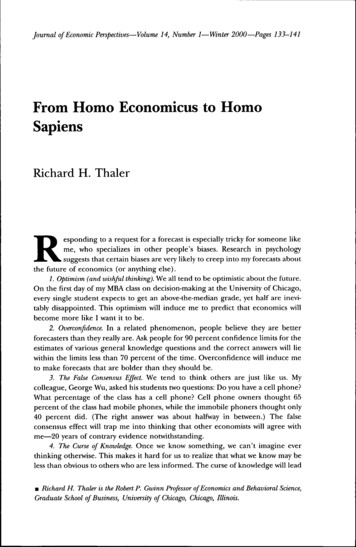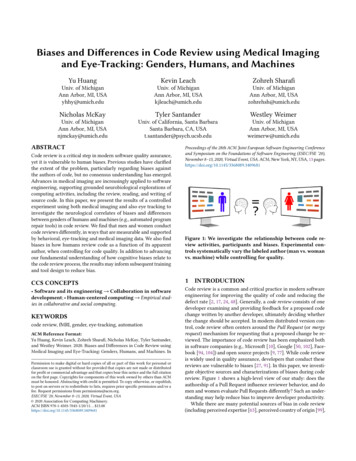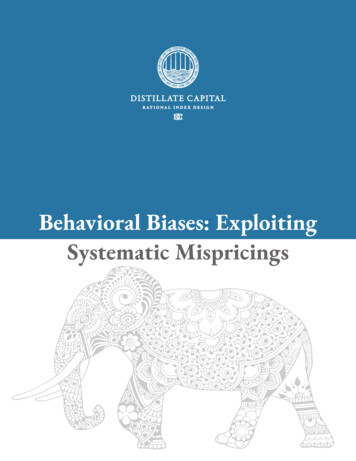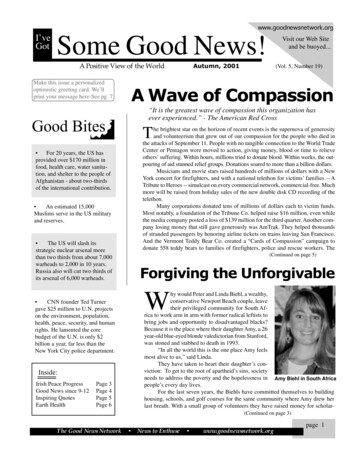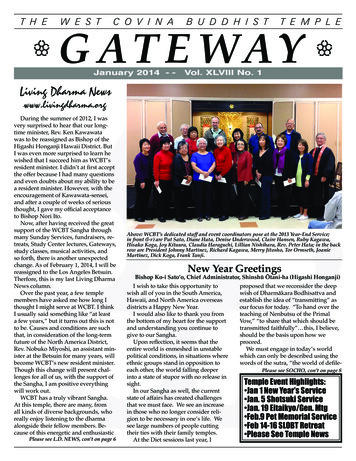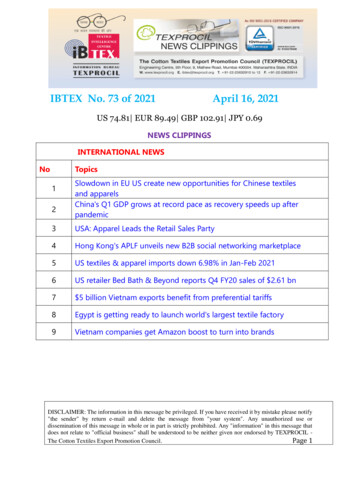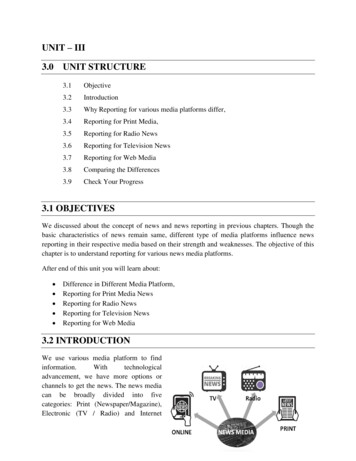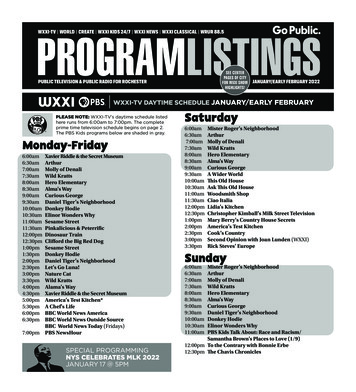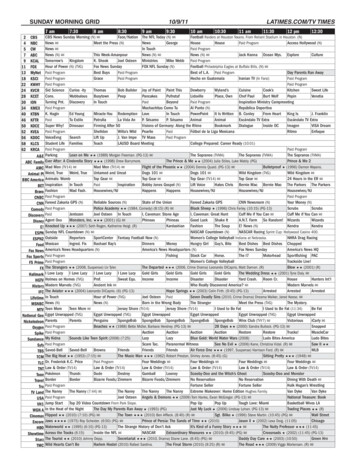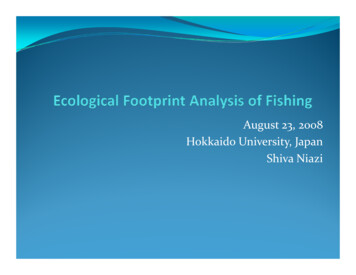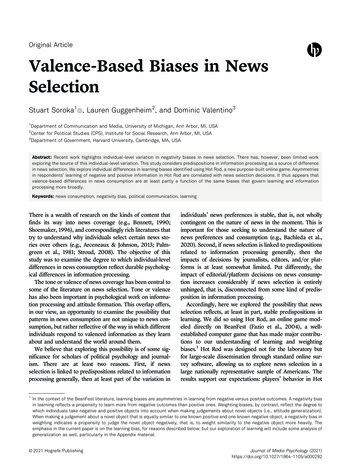
Transcription
Original ArticleValence-Based Biases in NewsSelectionStuart Soroka1 , Lauren Guggenheim2, and Dominic Valentino31Department of Communication and Media, University of Michigan, Ann Arbor, MI, USA2Center for Political Studies (CPS), Institute for Social Research, Ann Arbor, MI, USA3Department of Government, Harvard University, Cambridge, MA, USAAbstract: Recent work highlights individual-level variation in negativity biases in news selection. There has, however, been limited workexploring the source of this individual-level variation. This study considers predispositions in information processing as a source of differencein news selection. We explore individual differences in learning biases identified using Hot Rod, a new purpose-built online game. Asymmetriesin respondents’ learning of negative and positive information in Hot Rod are correlated with news selection decisions. It thus appears thatvalence-based differences in news consumption are at least partly a function of the same biases that govern learning and informationprocessing more broadly.Keywords: news consumption, negativity bias, political communication, learningThere is a wealth of research on the kinds of content thatfinds its way into news coverage (e.g., Bennett, 1990;Shoemaker, 1996), and correspondingly rich literatures thattry to understand why individuals select certain news stories over others (e.g., Arceneaux & Johnson, 2013; Palmgreen et al., 1981; Stroud, 2008). The objective of thisstudy was to examine the degree to which individual-leveldifferences in news consumption reflect durable psychological differences in information processing.The tone or valence of news coverage has been central tosome of the literature on news selection. Tone or valencehas also been important in psychological work on information processing and attitude formation. This overlap offers,in our view, an opportunity to examine the possibility thatpatterns in news consumption are not unique to news consumption, but rather reflective of the way in which differentindividuals respond to valenced information as they learnabout and understand the world around them.We believe that exploring this possibility is of some significance for scholars of political psychology and journalism. There are at least two reasons. First, if newsselection is linked to predispositions related to informationprocessing generally, then at least part of the variation in1individuals’ news preferences is stable, that is, not whollycontingent on the nature of news in the moment. This isimportant for those seeking to understand the nature ofnews preferences and consumption (e.g., Bachleda et al.,2020). Second, if news selection is linked to predispositionsrelated to information processing generally, then theimpacts of decisions by journalists, editors, and/or platforms is at least somewhat limited. Put differently, theimpact of editorial/platform decisions on news consumption increases considerably if news selection is entirelyunhinged, that is, disconnected from some kind of predisposition in information processing.Accordingly, here we explored the possibility that newsselection reflects, at least in part, stable predispositions inlearning. We did so using Hot Rod, an online game modeled directly on BeanFest (Fazio et al., 2004), a wellestablished computer game that has made major contributions to our understanding of learning and weightingbiases.1 Hot Rod was designed not for the laboratory butfor large-scale dissemination through standard online survey software, allowing us to explore news selection in alarge nationally representative sample of Americans. Theresults support our expectations: players’ behavior in HotIn the context of the BeanFest literature, learning biases are asymmetries in learning from negative versus positive outcomes. A negativity biasin learning reflects a propensity to learn more from negative outcomes than positive ones. Weighting biases, by contrast, reflect the degree towhich individuals take negative and positive objects into account when making judgements about novel objects (i.e., attitude generalization).When making a judgement about a novel object that is equally similar to one known positive and one known negative object, a negativity bias inweighting indicates a propensity to judge the novel object negatively, that is, to weight similarity to the negative object more heavily. Theemphasis in the current paper is on the learning bias, for reasons described below; but our exploration of learning will include some analysis ofgeneralization as well, particularly in the Appendix material.Ó 2021 Hogrefe PublishingJournal of Media Psychology (2021)https://doi.org/10.1027/1864-1105/a000292
2Rod – in which players learn based on both positive andnegative feedback – is associated with preferences for positive versus negative news headlines.BackgroundStory selection by users is a central feature of news consumption, especially as news consumption is increasinglyonline. Audience interests have always been central to newsselection, of course. It has, after all, always been the casethat the reader decides whether they will read or skip agiven newspaper story. But a reliance on “clicks” likelymakes audience-generating factors especially importantfor news consumption as well as production. And the abilityto be increasingly selective about news means that users’news content is increasingly influenced by their ownpreferences.These facts have been central to the burgeoning literature on selective exposure in news consumption (e.g.,Stroud, 2008), which highlights the role of cognitive dissonance (Festinger, 1962) – the discomfort felt when weencounter information that is contrary to our beliefs – asa driver of news selection. They also play a featured rolein work on negativity and outlyingness in news content(e.g., Lamberson & Soroka, 2018; Shoemaker, 1996), particularly work raising concerns about the possibility thatincreased selectivity will lead to audience-seeking mediacontent that is increasingly negative and sensationalistic.That news content is predominantly negative is foundational to scholars’ understanding of news media. There iswell-established literature on the frequency and impactsof both negative news content (e.g., Cappella & Jamieson,1997; Patterson, 1994) and negative political advertising(e.g., Lau et al., 1999; Valentino et al., 2011). There alsois work demonstrating that humans will on average prioritize negative information over positive information, generally speaking (e.g., Baumeister et al., 2001; Rozin &Royzman, 2001) and in politics and news consumptionspecifically (e.g., Soroka, 2014).A growing body of work also highlights variation aroundthis average behavior. Even as humans may on averageseek, respond to, and/or weigh negative information moreheavily than positive information, there appears to be agood amount of individual-level variation. That variationis highlighted in recent work on psychophysiological reactions to news content cross-nationally (Soroka et al.,2019a); it is evident in work that links variation in negativitybiases to political ideology (e.g., Oxley et al., 2008; Shook &Fazio, 2009); and it is evident in psychological work onlearning and attitude formation (e.g., Fazio et al., 2004)as well.Research that uses BeanFest to examine attitude formation alongside a range of related phenomena was especiallyJournal of Media Psychology (2021)S. Soroka et al., Valence-Based Biases in News Selectioninfluential for the present paper. The use of games to examine learning and/or information processing is well established. Games have been used as learning tools (Garriset al., 2002; Ke, 2011; Randel et al., 1992); they also havebeen used to explore psychological characteristics andmechanisms (e.g., Gobet et al., 2004; Lange et al., 2012),and to test formal models of behavior (e.g., Axelrod & Dawkins, 2006). BeanFest itself is a computer game played inthe lab. Participants are presented with a series of beansand must try to learn which beans to “approach” in orderto win points, based on variations in (a) how circular versusoval they are and (b) how many dots they have. After a series of practice rounds in which participants guess andreceive feedback, they play a final game in which they (a)make guesses with no feedback on which beans are healthyor unhealthy and (b) are faced with a combination of practiced and novel beans. This is, to be sure, a very thinaccount of the game, but more details are provided in theMethods section. The most critical feature of the gamefor the time being is that it allows researchers to examinevalence-based asymmetries in learning.Past work makes clear that the valence-based asymmetries captured in BeanFest are correlated with a range ofother attitudes, including negative cognitive style, depression, and anxiety (Shook et al., 2007). Valence-based asymmetries are associated with political ideology, wherebyconservatives show larger negativity biases in learning thanliberals (Shook & Fazio, 2009; in line with work finding asimilar relationship using psychophysiological measures,e.g., Oxley et al., 2008; although also see Bakker et al.,2020; Fournier et al., 2020). Subsequent research has alsolinked asymmetries captured in BeanFest play to participants’ reactions to stressful events (Pietri et al., 2012), tomeasures of negativity and risk (Pietri et al., 2013; Rocklage& Fazio, 2014), and the formation of social relationships(Rocklage et al., 2017). None of these phenomena is thefocus of the analyses here, but we see each as evidenceof the concurrent validity of measures extracted fromBeanFest gameplay. In short: Quantities identified inBeanFest have been linked to a broad range of attitudesand behaviors; for this reason, we are interested in whethera similar game might be used to explore valence-basedasymmetries in news consumption.The accumulated literature using BeanFest has relied ona number of variations on the rules of BeanFest, as well asthe ways in which BeanFest results are calculated, in orderto better explore particular aspects of both learning andattitude generalization. But the cumulative message of theliterature is relatively clear: Gameplay reveals asymmetriesin the weight that participants give to negative and positiveinformation, and those asymmetries are systematically connected with a range of measures of information processing,risk, and political and social attitudes.Ó 2021 Hogrefe Publishing
S. Soroka et al., Valence-Based Biases in News SelectionOur contention is that the asymmetry in learning revealedby a game such as BeanFest will be connected with mediaconsumption behavior as well. Note first that just as theBeanFest literature has revealed valence-based variationin learning, so too does recent work on reactions to newscontent. Recent studies highlight considerable variation inresponsiveness to negative and positive news coverage.Soroka et al. (2019a) demonstrate wide variation in psychophysiological reactions to positive and negative networknews stories within each of 17 different countries, forinstance. Soroka et al. (2019b) highlight this individual-levelvariation within the United States in particular. And just asBeanFest results have been linked to a range of sociopolitical attitudes, so too has the tendency to prioritize positive ornegative news content: Bachleda et al. (2020) examinedheadline-selection tasks across multiple countries and foundconnections between “negativity bias in news selection” andfactors such as government satisfaction and economicsentiment.Note also that the activity of news consumption is verysimilar to BeanFest. Indeed, the literature already considersnews consumption, at least in part, as a learning exercise(e.g., Lee, 2013; McCombs & Poindexter, 1983; Shoemaker,1996). The strength of a BeanFest-style game in this context is its ability to measure learning preferences in an environment that is entirely exogenous from current affairsnews; and then to examine the possibility that these asymmetries in learning are linked to news consumptionbehavior.We consider news selection as our dependent variable,and predispositions in learning as our independent variable.We hypothesize the following:Hypothesis 1 (H1): There will be a positive associationbetween valence-based asymmetries in news selection and valence-based asymmetries in learning.Insofar as this is the case, we suggest that it will offersupport for the claim that news consumption is driven atleast in part by individual-level differences in learning.MethodHot RodOur first objective was to adjust the BeanFest game with aneye toward creating a widely deployable measure of biasesin learning. We did so by developing an online video gamecalled “Hot Rod.” Hot Rod is similar to BeanFest in almostevery way, but instead of beans that vary in shape and dotswe use race cars that vary in rear wheel size and number ofracing stripes. Just as in BeanFest, the two dimensions have10 possible values (1 to 10). Panel A in Figure 1 shows twoÓ 2021 Hogrefe Publishing3examples of cars with minimal and then maximal values forboth wheels and stripes.As far as online games go, Hot Rod is not especiallysophisticated. Using the descriptions of variations of BeanFest in the existing literature, we built a series of gamerounds that can be fielded using the Qualtrics platform (albeit with adjustments using javascript; the modules used torun Hot Rod are now freely available through the HarvardDataverse at https://doi.org/10.7910/DVN/D7N8ZQ). Wesee the use of a standard survey platform as advantageousin that Hot Rod can be run in a relatively straightforwardway on a platform many researchers have access to. Wealso see the transition from beans to race cars as advantageous insofar as it makes the game a little more interesting.There are risks in moving to objects toward which participants may already have attitudes. We believe these risksare minimal in the case of cartoon race cars, however;and, moreover, we believe the minimal risks are offset bythe advantages of building an instrument that is more interesting and feels more like an online video game.The game presents race cars to participants in fiverounds – four practice rounds and a final game round. Inall rounds, participants must guess whether the Challengercar will defeat the Champion. For practice rounds, participants learn whether their guesses are correct or not – aftereach guess, there is a screen that shows the results of therace. At the beginning of each of the practice rounds, participants are given 100 points. With each correct guess, participants gain 10 points, and with each incorrect guess, theylose 10 points. If they reach 0 points the round restarts,while if they reach 200 points, they end the round early.Panels C and D of Figure 1 show examples of the guessingscreen and the results screen from the four practice rounds.Rounds 1 and 3 use the same set of 12 cars in randomorder; Rounds 2 and 4 use a different set of 16 cars in random order. Not all of the 100 possible wheel and stripecombinations are used, as can be seen in Panel B ofFigure 1. The panel maps out the cars that will win (solidshapes) or lose (hollow shapes), as well as the cars shownin the first, second, third, fourth, and game rounds. Themap itself is exactly the same as is typically used in BeanFest, although the number of cars/beans presented in eachround differs slightly (across BeanFest versions, and here).Note that learning the right combinations of wheels andstripes is difficult – there are not-straightforward combinations of the two that will win or lose. And participants mustmake their decisions in 10 s, after which time they are presented with the results screen (and no change in theirpoints).In the final game round, participants are told that theywill no longer receive feedback – they must simply maketheir guesses with no results screen or points tally untilthe end of the game. This round features 40 cars, asJournal of Media Psychology (2021)
4S. Soroka et al., Valence-Based Biases in News Selectionindicated in Figure 1B. Note that half of these cars are onesthat have been seen in prior rounds, and others are novel –proximate/similar to prior cars, but marginally different.(Novel cars are central to a measure of attitude generalization, i.e., they capture participants’ ability to generalize fromwhat they have learned in prior rounds (see Footnote 1)).As in the practice rounds, game-round cars are presentedin random order. Each car now times out after only 5 s, afterwhich the game moves on to the next car. The final score isgiven as a proportion of the 40 cars guessed correctly, wheremissed cars are counted as incorrect responses.Given results in prior work (esp. Fazio et al., 2004; Shooket al., 2007), we focus on the full-feedback variant of ourgame, in which participants learn about cars regardless ofwhether they guess win or lose.2 And we rely on a singlemeasure common in the BeanFest literature: a learning biasbased on the number of game-round correct guesses, bypositive or negative valence (winning vs. losing cars). Wediscuss this measure in more detail in the Results section.SurveyThe data we relied on are based on an online sample of USrespondents, collected in two waves by YouGov. YouGovuses a sample matching procedure to derive representativesamples from nonrandomly selected pools of online respondents.3 The response rate was 24.1%; demographic detailsfor respondents who completed the survey are providedin Appendix Table A1.All respondents play the Hot Rod game, after which theycomplete a series of survey questions fielded in the sameQualtrics platform. The survey begins with headline-selection tasks that make up our measure of negativity biasesin news selection (NBNS). The measure has been designedand tested elsewhere (Bachleda et al., 2020), and is relatively straightforward: In each of five questions, participantsare asked to indicate which of four headlines they wouldlike most to read. In each case, there are two positive andtwo negative headlines, in random order. Selections aremade across five topics – the economy, the environment,health, politics, and foreign affairs – also in random order.The question wording and headlines are as follows.Imagine that you are going to read a news story inorder to learn something interesting, important oruseful about the ECONOMY. You have FOUR headlines from which to make ONE selection. Which ofthe following would you read?: Experts Deeply Worried about Rising Cost of Living; Inflation FiguresReleased: Outlook Is Positive; Employment Up FromLast Month; Has Employment Already Peaked?Future Prospects Worsen. . . ENVIRONMENT. . . Which of the following wouldyou read?: Scientists Offer Warnings About DepletedOzone Layer; Monthly Trend Suggests Improvementin Global Warming; Report Suggests Rising ConcernsAbout Rising Temperatures; Successful ReforestationOffers Signs of Hope. . . POLITICS. . . Which of the following would youread?: Support for Government at All-Time Low;Assistance in Sight for Congressional Leadership;Congress Fumbles Again; Parties Succeed in Rebuilding Bases of Support. . . HEALTH CARE. . . Which of the following wouldyou read?: Easy Ways to Improve Heart Health; WhyAre Heart Attacks on the Rise?; Doctors’ Healthy Eating Tips; Meals That Can Harm Your Health. . . FOREIGN AFFAIRS. . . Which of the followingwould you read?: Global Trade Summit Widely Criticized; Foreign Leaders Convene to Improve TradeRelations; Explosions Shock Diplomats Across theMiddle East; Positive Shift in Middle East Talks.The objective is to capture participants’ tendency to selectnegative headlines over positive headlines, across a range2A “contingent feedback” version of BeanFest offers feedback on whether a bean is healthy or unhealthy only when participants select approach(equivalent to win in Hot Rod); if participants choose not to approach (equivalent to los
learning. We did so using Hot Rod, an online game mod-eled directly on BeanFest (Fazio et al., 2004), a well-established computer game that has made major contribu-tions to our understanding of learning and weighting biases.1 Hot Rod was designed not for the laboratory but for large-scale dissemination through standard online sur-
